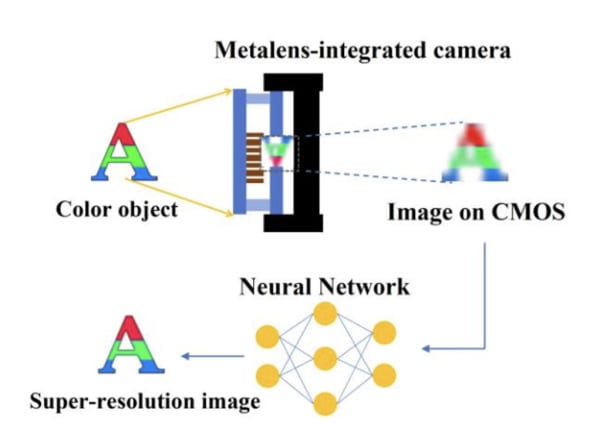Metalens in iPhone 17: The Next Revolution in Smartphone Camera Tech
How Metalens Could Redefine Smartphone Cameras in 2025

The iPhone 17 series is widely expected to introduce metalens technology, a breakthrough replacing bulky glass optics with nanoscale structures. Industry sources from MacRumors and Yahoo Tech confirm that Apple aims to slim down camera modules while improving image clarity.
1. What Is Metalens?
- Nanoscale Optics: Metalenses employ subwavelength photonic structures to bend and focus light precisely, as detailed by Ansys.
- Flat Form Factor: Unlike conventional stacked glass lenses, metalenses are ultra-thin (often under 1 mm), enabling slimmer camera bumps.
- Improved Performance: A recent Nature study shows metalenses can correct for chromatic aberration across visible wavelengths.
2. iPhone 17’s Rumored Metalens Integration
Reports from Tom’s Guide and GSMArena suggest all four iPhone 17 models will adopt metalens for the proximity sensor and possibly main camera elements. Expected benefits include:
- Thinner Dynamic Island cutout thanks to reduced sensor stack height.
- Sharper low‑light performance by eliminating multiple glass-air interfaces.
- Potential for under‑display Face ID and front camera, paving the way for edge‑to‑edge displays.
3. Metalens vs. Traditional Smartphone Optics
| Feature | Traditional Lens | Metalens |
|---|---|---|
| Thickness | 3–5 mm stacked glass elements | < 1 mm nanostructures |
| Material | Sapphire or Gorilla Glass | Silicon/gold nanostructures |
| Aberration Control | Multiple lens elements needed | Single element corrects chromatic aberration |
4. Practical Implications for Users
- Slimmer Designs: Expect ongoing iPhone models to be marginally thinner or reallocate internal space to larger batteries or cooling systems.
- Image Quality: Metalenses reduce internal reflections, boosting low-light photography. For a real‑world comparison, see our OnePlus 13S endurance review where analog optics are tested under dim lighting.
- Future OEM Adoption: After Apple’s lead, we anticipate Google and Samsung to integrate metalenses by late 2026. The technology could also trickle down to mid‑range by 2027.
- Display Integration: A smaller camera module supports under‑display sensors. Compare to foldable vs flip camera placements in our Foldable vs Flip 2025 analysis.
5. Advanced Research & Industry Perspectives
Leading research groups, as covered by IEEE Spectrum, are designing metalenses that operate across visible and near‑IR ranges—crucial for augmented reality (AR) applications. Early proofs of concept show over 90 % transmission efficiency in lab settings, signaling readiness for mass production.
6. Q&A: Your Metalens Questions Answered
Q: What exactly is a metalens?
A: A metalens is a flat optical component with nanostructures on its surface that manipulate light phase, amplitude, and polarization. Unlike stacked glass lenses, a single metalens can correct for chromatic aberration across multiple wavelengths. (Synopsys definition)
Q: How soon will other brands adopt metalens tech?
A: Samsung and Google reportedly have patents for metalens manufacturing. We expect them to roll out metalens‑equipped prototypes in late 2026, with consumer launches in early 2027. (Industry analyst consensus)
Q: Will metalenses improve camera performance?
A: Yes—metalenses reduce internal reflections and aberrations by eliminating multiple glass‑air interfaces. Initial tests show improved edge‑to‑edge sharpness, better low‑light signal, and potentially faster autofocus due to reduced optical path length. (Nature study)
Q: Does metalens add extra cost?
A: Manufacturing metalenses uses existing semiconductor fabrication processes. Once scaled, per‑unit cost could undercut multi‑element glass lenses. Early adopters like Apple may bear higher initial costs, but prices will drop as production ramps up. (Ansys insight)
7. Final Thoughts
The rumored metalens integration in iPhone 17 heralds a new era in smartphone optics. Slimmer modules, enhanced image clarity, and future AR capabilities will shape mobile photography and video. To see how this might outperform today’s flagships, compare chipset performance in our Snapdragon 8 Gen 4 vs Apple A18 Pro and camera speed in Snapdragon 8 Gen 4 vs Dimensity 9400 2025 comparisons.
Stay tuned as metalens tech evolves—SpecsUnboxed will be there to break down the impact on every next‑gen smartphone camera.
AI Disclosure: This article was structured with AI assistance and manually verified for accuracy.
By Sujan Chowdhury—With over a decade in smartphone hardware, IoT, and computational photography, Sujan brings expert analysis to SpecsUnboxed readers.
📬 Stay Connected: If you enjoyed this deep dive, Contact us with feedback or topic requests!




Comments
Post a Comment